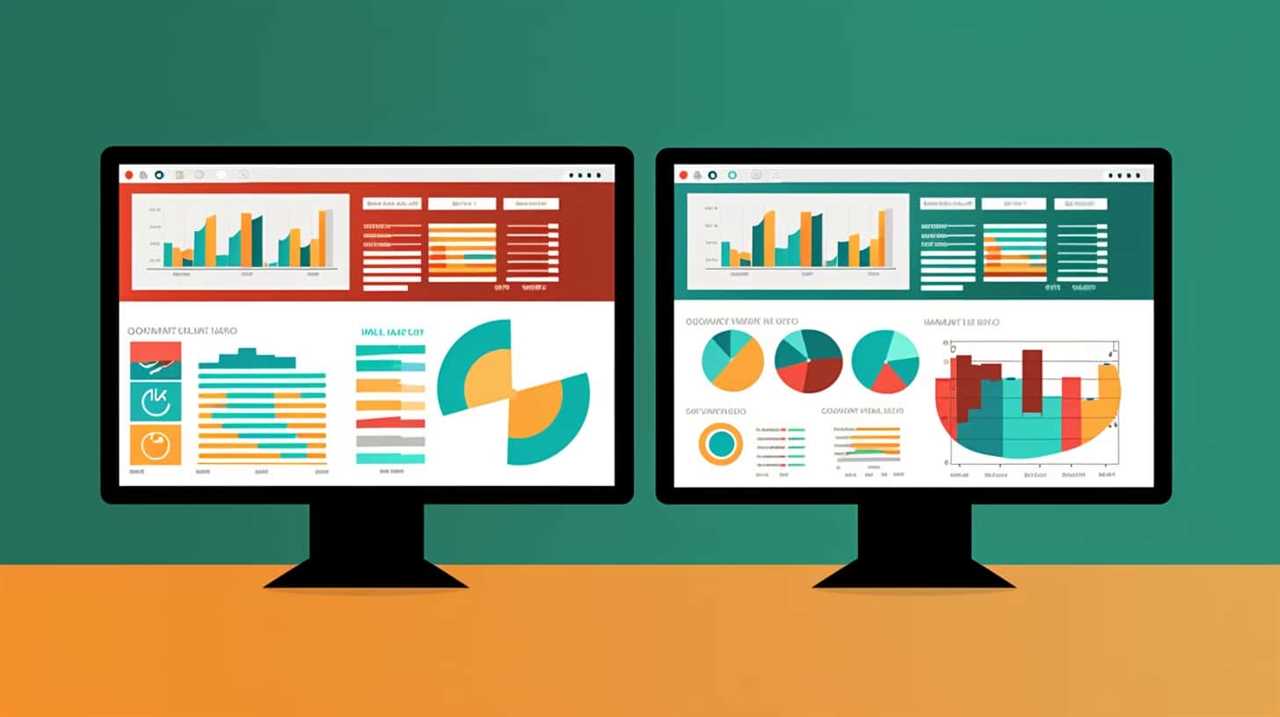Struggling to make your local enterprise stand out in an overcrowded market? Look no further! We possess the unique insider insights on equipping your business with that distinctive hyperlocal edge.
Boost your visibility and attract more customers with these 12 expert tips. From optimizing your online listings to engaging with the local community, we’ve got you covered.
Get ready to take your local business to the next level and achieve mastery in your market.
Key Takeaways
- Ensure accurate and up-to-date information in local business listings
- Implement local SEO strategies to target specific neighborhoods and improve local search rankings
- Encourage positive online reviews to enhance local business visibility and improve search engine rankings
- Utilize social media marketing to boost local business visibility, engage with the audience, and collaborate with local influencers for wider reach and increased credibility.
Optimize Your Google My Business Listing
To optimize our Google My Business listing, we need to ensure that all relevant information, such as our address, phone number, and business hours, is accurate and up-to-date. By doing so, we can optimize our online presence and increase our local search rankings.

A well-optimized Google My Business listing not only provides potential customers with essential information about our business but also improves our visibility in local search results. This is crucial for attracting local customers and staying ahead of our competitors.
To achieve this, we must regularly review and update our listing with any changes to our business information. Additionally, we should include high-quality photos, respond to customer reviews, and utilize the various features offered by Google My Business, such as posts and messaging.
Claim and Update Your Online Directory Listings
When it comes to boosting your local business visibility, claiming and updating your online directory listings is crucial.
Accurate listings not only help potential customers find your business, but they also maximize your online visibility.

Importance of Accurate Listings
Claiming and updating online directory listings is crucial for boosting our local business visibility. Accurate listings play a significant role in improving our online presence and attracting potential customers. When our business information is consistent across different platforms, it enhances our credibility and helps us rank higher in search engine results. In fact, accurate listings have a direct impact on several local business visibility metrics, such as search engine rankings, online reviews, and customer engagement.
To highlight the importance of accurate listings, let’s take a look at the following table:
| Metrics | Importance of Accurate Listings |
|---|---|
| Search Rankings | Accurate listings improve our chances of appearing at the top of search results, increasing visibility to potential customers. |
| Online Reviews | Accurate listings ensure that customers can find and review our business, which can influence their decision-making process. |
| Customer Engagement | Accurate listings provide reliable information, making it easier for customers to contact or visit our business. |
| Trust and Credibility | Accurate listings instill confidence in potential customers, helping our business establish a trustworthy reputation. |
| Brand Consistency | Accurate listings across various platforms help maintain a consistent brand image, reinforcing recognition and trust among customers. |
Maximizing Online Visibility
Updating our online directory listings is essential for maximizing our local business visibility and attracting potential customers. In today’s digital age, having a strong online presence is crucial for improving local search rankings and staying ahead of the competition. Here are three reasons why updating our online directory listings should be a top priority:
- Increased visibility: By claiming and updating our online directory listings, we can ensure that accurate and up-to-date information about our business is readily available to potential customers. This increases our visibility and makes it easier for people to find us when they’re searching for products or services in our area.
- Trust and credibility: Consistent and accurate information on online directories helps establish trust and credibility with our audience. When customers see that our business is listed on reputable directories, they’re more likely to trust us and choose our products or services over competitors.
- Enhanced customer experience: Updating our online directory listings allows us to provide additional details about our business, such as operating hours, contact information, and customer reviews. This creates a positive customer experience and makes it easier for potential customers to make informed decisions about choosing our business.
Updating our online directory listings is just the first step in maximizing our online visibility. In the next section, we’ll discuss how to implement local SEO strategies to further boost our local business visibility and attract more customers.

Implement Local SEO Strategies
When it comes to boosting your local business visibility, implementing local SEO strategies is key.
To start, target specific neighborhoods in your area to optimize your chances of reaching the right audience.
Utilize Google My Business to its fullest potential by ensuring your business information is accurate and up-to-date.
Lastly, don’t underestimate the power of local backlinks. Building relationships with other local businesses and getting them to link back to your website can greatly improve your local search rankings.

Target Specific Neighborhoods
To enhance our local business visibility, we implement targeted neighborhood strategies and employ local SEO techniques. By focusing on specific neighborhoods, we can tailor our advertising efforts to reach the right audience and create a sense of community connection.
Here are three reasons why targeting specific neighborhoods through hyperlocal marketing strategies is crucial:
- Increased Relevance: By using neighborhood-specific advertising, we can deliver our message directly to the people who are most likely to be interested in our products or services. This increases the relevance of our marketing efforts and improves the chances of attracting local customers.
- Personalized Approach: Hyperlocal marketing allows us to connect with potential customers on a more personal level. By understanding the unique characteristics and interests of specific neighborhoods, we can tailor our messaging to resonate with their needs and preferences.
- Word-of-Mouth Potential: When we focus on specific neighborhoods, we’ve the opportunity to build strong relationships with local customers. Satisfied customers are more likely to spread the word about our business within their neighborhood, leading to valuable word-of-mouth referrals.
Optimize Google My Business
As we continue to enhance our local business visibility, one of the key strategies we implement is optimizing our Google My Business listing with local SEO strategies.
Google My Business optimization is crucial for boosting our visibility in local search engine marketing. By optimizing our listing, we ensure that our business appears prominently in Google Maps and search results when potential customers are looking for products or services in our area.

This involves filling out all the necessary information, such as our address, phone number, and business hours, and regularly updating our profile with new photos and posts.
We also encourage our customers to leave reviews, as positive reviews can significantly improve our ranking.
Get Local Backlinks
To further boost our local business visibility, we continue to implement local SEO strategies by actively seeking out local backlinks. These backlinks play a crucial role in improving our search engine rankings and driving more organic traffic to our website.
Here are three reasons why local partnerships and community outreach are essential for gaining valuable local backlinks:

- Building trust and credibility: By partnering with local businesses and organizations, we can establish ourselves as a reputable and trustworthy brand in the community. This can lead to other businesses and websites linking to our website, boosting our online visibility.
- Increasing brand exposure: Collaborating with local partners allows us to tap into their existing audience and gain exposure to potential customers who may not have heard of us before. This can result in more website visits and potential backlinks from their audience.
- Enhancing local relevance: When local websites and directories link to our business, it signals to search engines that we’re relevant to the local area. This can greatly improve our local search rankings and make it easier for customers in our area to find us.
Encourage Positive Online Reviews
We actively promote our customers to leave positive online reviews to enhance our local business visibility. Online reputation management is essential in today’s digital age, and positive customer feedback is one of the most effective ways to build a strong online reputation.
When potential customers search for local businesses, they often rely on online reviews to make informed decisions. By encouraging positive reviews, we can showcase our excellent products and services and attract more customers.
Furthermore, positive reviews can help improve our search engine rankings, making it easier for people to find us online. We understand the importance of maintaining a positive online reputation, and we value our customers’ feedback.
That’s why we strive to provide exceptional experiences and encourage our customers to share their positive experiences online. Together, we can boost our local business visibility and attract more customers to our doorstep.

Utilize Social Media Marketing
One effective way to boost our local business visibility is through utilizing social media marketing. Social media platforms provide us with a powerful tool to engage with our audience and build a strong online presence.
Here are three reasons why social media engagement is crucial for our local business:
- Increased Reach: Social media allows us to reach a wider audience beyond our physical location. By connecting with people in our community and beyond, we can expand our customer base and attract new customers.
- Customer Testimonials: Social media provides a platform for our satisfied customers to share their positive experiences. Local customer testimonials are a powerful form of social proof that can influence potential customers to choose our business over competitors.
- Brand Awareness: Regularly posting engaging content on social media helps to increase brand visibility and awareness. By showcasing our products, services, and expertise, we can position ourselves as the go-to local business in our area.
Collaborate With Local Influencers
Collaborating with local influencers can greatly benefit your business’s visibility in the community.
By partnering with influencers who have a strong following and influence in your local area, you can tap into their audience and gain exposure to potential customers.

These influencers can help promote your products or services through their social media channels, blog posts, or in-person events, allowing you to reach a wider audience and build trust among your target market.
Influencer Marketing Benefits
Working with local influencers can significantly enhance the visibility of your local business. Here are some benefits of collaborating with influencers:
- Increased Reach: Local influencers have a dedicated following in your community, allowing you to tap into a wider audience and gain exposure to potential customers.
- Credibility and Trust: When local influencers endorse your business, it adds credibility and builds trust among their followers. People are more likely to trust recommendations from someone they admire and respect.
- Authenticity: Local influencers have a deep understanding of your community and its preferences. Their collaborations with your business can create an authentic connection with your target audience, making your brand more relatable and appealing.
By leveraging influencer partnerships and implementing effective influencer marketing strategies, you can amplify your local business’s visibility, attract new customers, and establish a strong presence in your community.
Don’t miss out on this valuable opportunity to boost your local business’s success.

Local Influencer Collaboration
We love collaborating with local influencers to boost our local business visibility. Partnering with influencers who have a strong presence in our community allows us to reach a wider audience and create a genuine connection with potential customers. By leveraging their influence and credibility, we can effectively promote our products or services to a highly engaged audience.
Influencer outreach is a powerful marketing strategy that can significantly impact our local business. When collaborating with local influencers, we benefit from their existing relationships and trust with their followers. This makes their endorsement of our brand more authentic and persuasive.
To illustrate the impact of local influencer collaboration, here is a table showcasing the potential benefits:
| Benefits of Local Influencer Collaboration |
|---|
| Increased brand visibility |
| Enhanced credibility and trust |
| Access to a targeted audience |
| Higher engagement and conversion rates |
| Cost-effective advertising |
Run Geographically Targeted Ads
To maximize local business visibility, utilizing geographically targeted ads is essential. Geographically targeted marketing allows businesses to reach their target audience precisely, ensuring that their ads are seen by potential customers in specific locations. Location-based advertising takes advantage of advanced technology to deliver ads to individuals based on their physical location, increasing the chances of engagement and conversions.

Here are three reasons why running geographically targeted ads is crucial for your local business:
- Increased relevance: By targeting ads to specific geographical areas, you can tailor your message to resonate with the local audience, making it more relevant and compelling.
- Higher conversion rates: When you focus your advertising efforts on people who are in close proximity to your business, you’re more likely to attract customers who are ready to make a purchase.
- Cost-effective advertising: Geographically targeted ads allow you to allocate your advertising budget more efficiently by reaching only those individuals who are most likely to convert.
Running geographically targeted ads can significantly boost your local business visibility and generate more leads.
With that being said, another effective strategy to enhance your local presence is to host local events and workshops.
Host Local Events and Workshops
Organizing local events and workshops can greatly enhance our local business visibility. By hosting local meetups and organizing community events, we have the opportunity to connect with our target audience on a personal level and showcase our expertise. These events provide a platform to engage with potential customers, build relationships, and establish ourselves as industry leaders in our community.

To make the most of these opportunities, it’s important to plan and execute events that resonate with our target audience. Here is a table outlining four key tips for hosting successful local events and workshops:
| Tips for Hosting Local Events and Workshops |
|---|
| 1. Understand your target audience |
| 2. Choose a relevant and appealing topic |
| 3. Promote the event through various channels |
| 4. Provide valuable content and networking opportunities |
Partner With Other Local Businesses
One effective strategy for boosting our local business visibility is partnering with other local businesses. By collaborating with other companies in our community, we can leverage each other’s strengths and resources to attract more customers and increase brand awareness.
Here are some partnering opportunities and cross promotion strategies that can help us maximize our visibility:
- Joint Marketing Campaigns: Partnering with complementary businesses allows us to pool our marketing efforts and reach a wider audience. By cross-promoting each other’s products or services, we can tap into new customer bases and generate more buzz for our businesses.
- Co-hosting Events: Collaborating on events such as workshops, seminars, or charity drives not only brings our businesses together but also creates a sense of community. This can foster goodwill among customers and show them that we’re invested in the local area.
- Referral Programs: Establishing referral partnerships with other local businesses can be mutually beneficial. By referring customers to each other, we can build trust and credibility, while also expanding our customer base through word-of-mouth recommendations.
Offer Hyperlocal Promotions and Discounts
By offering hyperlocal promotions and discounts, we can further enhance our visibility and attract more customers in our local community. Hyperlocal advertising strategies are a powerful tool for targeting local customers and increasing our business’s presence in the neighborhood. When we offer exclusive discounts or promotions specifically tailored to our local audience, we demonstrate our commitment to the community and build a loyal customer base.

One effective strategy is to partner with other local businesses to create joint promotions. This can help us reach a wider audience and increase our visibility within the community. By cross-promoting with complementary businesses, we can offer bundled discounts or special deals that appeal to local customers looking for a complete experience.
Another approach is to target specific local events or holidays. By offering promotions or discounts that coincide with these events, we can tap into the excitement and attract customers who are actively seeking local activities and deals.
In addition to traditional advertising channels, we can leverage social media platforms to promote our hyperlocal promotions and discounts. By using location-based targeting and relevant hashtags, we can reach potential customers who are already engaged with the local community.
Engage With the Local Community
As we continue to build our local business visibility, it’s essential to engage with the local community to foster strong relationships and establish ourselves as active members within the neighborhood. By getting involved in the community, we not only show our commitment to the area but also create a sense of trust and loyalty among residents.

Here are three reasons why engaging with the local community is crucial:
- Enhanced Brand Reputation: Supporting local volunteer opportunities and community outreach initiatives showcases our dedication to making a positive impact. This helps build a favorable brand reputation in the eyes of the community.
- Word-of-Mouth Marketing: Engaging with the local community generates buzz and encourages positive word-of-mouth referrals. Satisfied customers will share their experiences with friends and family, resulting in increased visibility and potential new customers.
- Greater Customer Loyalty: When customers see that we’re actively involved in the neighborhood, they feel a connection and are more likely to choose our business over competitors. Building this rapport with the community fosters long-lasting relationships and cultivates customer loyalty.
By actively engaging with the local community, we position ourselves as more than just a business but as a valued member of the neighborhood, ultimately boosting our local business visibility.
Let’s make a difference together!
Track and Analyze Your Local Business Visibility Metrics
To effectively boost our local business visibility, it’s crucial that we track and analyze our local business visibility metrics. By doing so, we can gain valuable insights into how our business is performing in the local market and identify areas for improvement.

One important metric to track is customer feedback. By actively monitoring and analyzing customer feedback, we can understand what our customers like and dislike about our business, allowing us to make necessary adjustments to better meet their needs.
Additionally, it’s essential to monitor our online reputation. This involves tracking reviews, ratings, and mentions of our business across various online platforms. By staying on top of our online reputation, we can address any negative feedback promptly and showcase positive reviews to potential customers.
Frequently Asked Questions
How Can I Optimize My Website for Local Search Results?
To optimize our website for local search results, we focus on local SEO and location-based marketing strategies. By targeting specific keywords and creating relevant content, we increase our visibility and attract potential customers in our area.
What Are the Best Practices for Managing Online Customer Reviews?
When it comes to managing online customer reviews, our best practices include responding to customer feedback promptly and building trust through positive reviews. These strategies help us enhance our reputation and attract more customers.

How Can I Effectively Utilize Social Media to Promote My Local Business?
To effectively utilize social media for our local business, we focus on social media engagement and local business networking. By connecting with our community, sharing valuable content, and building relationships, we boost our visibility and attract more customers.
Are There Any Strategies for Targeting Specific Geographical Areas With Online Advertisements?
Geo targeting techniques and local ad campaigns are effective strategies for reaching specific geographical areas with online advertisements. By tailoring our ads to the local audience, we can boost visibility and attract more customers to our local business.
What Tools or Methods Can I Use to Track and Analyze the Visibility of My Local Business Online?
To track and analyze the online visibility of our local business, we use various tools and methods. With online visibility tracking and digital marketing analytics, we can measure our reach and effectiveness, ensuring our strategies are working.
Conclusion
Boosting your local business visibility is crucial for success in today’s competitive market. By optimizing your Google My Business listing, claiming and updating online directory listings, and implementing local SEO strategies, you can increase your online presence.

Encouraging positive online reviews, utilizing social media marketing, and partnering with other local businesses can further enhance your visibility.
Offering hyperlocal promotions and discounts, engaging with the local community, and tracking your metrics will help you stay ahead.
Like a vibrant garden blooming with opportunities, these strategies will make your business stand out in the crowd.










